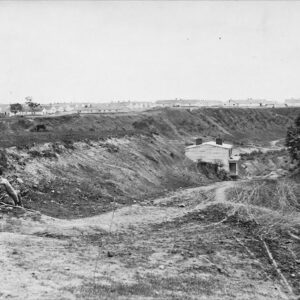Tag: Chimborazo Hospital (Richmond VA)
Wikipedia says: Chimborazo Hospital was a Civil War-era facility built in Richmond, Virginia to service the medical needs of the Confederate Army. It functioned between 1862 and 1865 in what is now Chimborazo Park, treating over 76,000 injured Confederate soldiers. During its existence, the hospital admitted nearly 78,000 patients and between 6,500 and 8,000 of these patients died. This mortality rate of between 8.3 and 10.3 percent is among the lowest such rates of period military hospitals.
After the war, the Hospital became a refuge for freed slaves.
In the early days of the Civil War, most people did not expect the conflict to last more than a few months, so the Confederate government failed to immediately establish many kinds of necessary military infrastructure, including medical infrastructure. Many soldiers were sent to civilian houses to receive medical care, resulting in both unsatisfactory care and the illness of many caretakers. Most Richmond-area military hospitals were not purpose-built buildings, but rather repurposed existing structures, including warehouses, hotels, homes, and stores. These facilities quickly became overcrowded, and Samuel P. Moore, the new surgeon general of the Confederacy, needed to quickly identify new potential hospital sites.
Simultaneously and coincidentally, on an undeveloped plateau on the east end of Richmond called Chimborazo Hill, slaves began building a permanent winter quarters, including soldiers’ barracks, officers’ quarters, three hospitals, and a bake house. Since most Confederate soldiers would be wintering further north, Moore decided to convert the barracks into a hospital, appointing Dr. James B. McCaw, a professor at the Medical College of Virginia, as surgeon-in-chief.
The name Chimborazo is said to have been inspired by Mount Chimborazo, in Ecuador.
Facilities and operation
Record keeping at Chimborazo Hospital was meticulous. There were ninety hospital wards, which all had shingled roofs, wood-plank floors, and whitewashed walls (interior and exterior). Each side of each building had three doors and ten windows; each window had a white curtain. Each ward was warmed by a wood stove and lit at night by a single candle. Each ward measured eighty by twenty feet and contained approximately forty beds. In addition to hospital wards, there were also bake houses, kitchens, ice houses, a soap house, a stable, a guard house, a chapel, a bathhouse, carpenter, blacksmith and apothecary shops, and five dead houses. Each building was surrounded by wide avenues, as McCaw believed fresh air was a medical necessity for recovery.
McCaw established a strict formal organizational structure, including divisional hospitals, surgeons, assistant surgeons, acting assistant surgeons, stewards, ward masters, nurses, druggists, cooks, dentists, and matrons. All surgeons were required to have at least five years of medical experience. Other positions were filled by soldiers, free blacks, slaves, and white women. For most of the war, even when the wounded from the nearby Seven Days Battles required tents to accommodate overflow, food was sufficient and medical care received praise. However, as occurred at all hospitals of the day, available resources were not always sufficient and sometimes organizational structures broke down, leading to insufficient care and an unsanitary environment. Soldiers who died at Chimborazo were buried at Oakwood Cemetery.
Showing the single result
